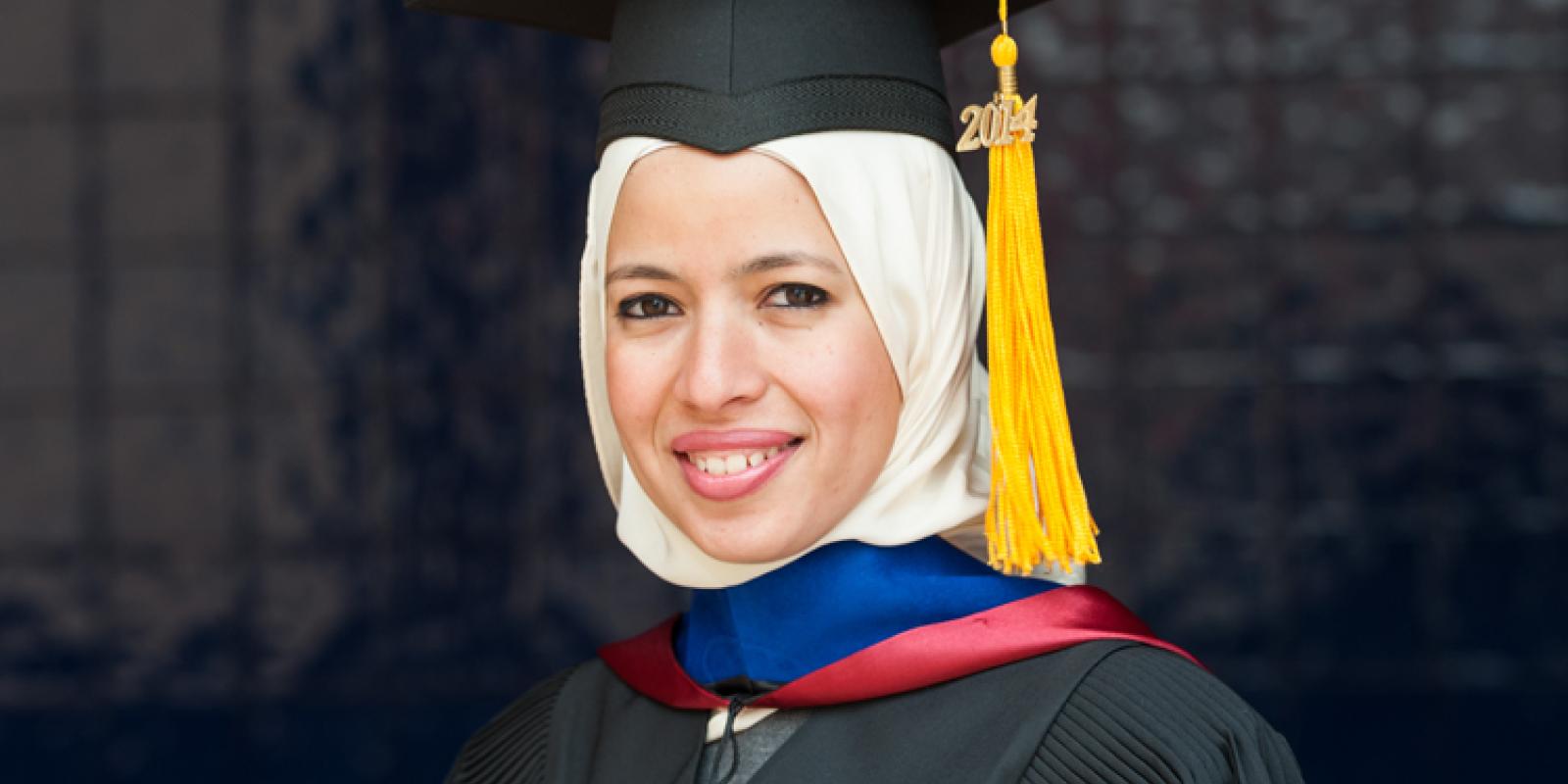
First PhD Graduate Designs Sustainable System for Desert Climates
Yosra El Maghraby (’04, ’08, ’14), a construction engineer and AUC’s first-ever PhD graduate, has designed a sustainable building system suited for the dry, hot climates of the Middle East and Gulf countries. Walking down the aisle during the midyear commencement, her goals were set in front of her: advancing her research and teaching.
“I am happy to have received my PhD after years of hard work, and am especially proud that I’ve earned it from my beloved AUC,” said El Maghraby, who holds bachelor’s and master’s degrees in construction engineering from the University. “I love having an academic career, and I really enjoy working with students.” El Maghraby is the first graduate of the University's PhD program, which was established through a generous donation by Yousef Jameel '68, AUC alumnus and renowned businessman and philanthropist.
El Maghraby’s thesis focuses on the development of sustainable desert communities, constructing buildings that are not only environmentally friendly, but also strong enough to withstand any loads such as wind or earthquakes. The idea began as a project, Integrated Desert Building, funded by the King Abdullah University of Science and Technology. The late Provost Medhat Haroun introduced El Maghraby to the project. “I was excited about this type of work because it is challenging and, at the same time, relevant to the region,” explained El Maghraby. “The Gulf area is generally very hot, and buildings there are air-conditioned all the time, which consumes an enormous amount of energy. The project aims to find ways to cut down on this energy consumption.”
El Maghraby began designing a wall using a system called insulating concrete form, which utilizes insulating foam to reduce the amount of concrete in a structure by about 40 percent. “This insulation cuts down on energy consumption, so it’s sustainable in that sense,” she said, “The amount of concrete used is also decreased, which is great because cement factory production results in a lot of pollution.”
One of the greatest challenges of the project was procuring the raw materials necessary for the test trials, noted El Maghraby. “Although this type of building system is used in North America, there is very little knowledge about it in the Middle East,” she said. “Since very little is known about this type of foam work, we still don’t have any factories that manufacture it.” Consequently, El Maghraby and her team had to manufacture the foam themselves in the construction engineering lab at AUC, an accomplishment described by her thesis advisers as “very impressive.”
Highlighting El Maghraby’s achievements, Mohamed Naguib Abou-Zeid, chair of the construction engineering department and one of El Maghraby's advisers, noted, “I am pleased to have taught Yosra five courses in the undergraduate, graduate and PhD levels. I have witnessed her excel, particularly during her master’s research, which I happened to supervise. Her work was acknowledged, published and presented in Washington, D.C., where I was among the audience members. As for her PhD, I must say that Yosra worked her way steadily and confidently. Her quiet nature allowed her to sail through the challenging road of a topic that is not easy to handle. I assure you that everyone who knows her was so pleased to see her receive her PhD.”
For El Maghraby, the challenging nature of the project is what drew her to it. “I chose to do my PhD in structure analysis and design because it is the most difficult area of construction engineering,” she noted. “I did my master’s in another area –– materials engineering –– and after finishing my degree, I thought to myself, ‘I think I’d like to challenge myself in something different.’ So I became a research assistant one semester before the PhD program began, working alongside Dr. Haroun and Dr. Ezzat Fahmy.”
Acknowledging her advisers’ support, El Maghraby added, “Dr. Haroun, may he rest in peace, was a great person. He helped me in everything, both technically and in helping secure funding for me for the project. At one point, the funding stopped, and he had to source it from somewhere else. He didn’t tell me because he didn’t want me to get distracted from my work. Dr. Fahmy, who I am assisting right now, was dean of the School of Sciences and Engineering when I started studying for the qualifying exam, and he literally gave me all the time one could give, even when I just had a silly question to ask. The faculty here at AUC are the best.”
Looking ahead, El Maghraby plans to continue her research on the sustainable foam wall, developing a first-of-its-kind design guideline for it. “If we, as a team from AUC, issue the design guidelines for this, it would be a great achievement because the University would always be referenced in any work or construction process that makes use of these guidelines,” El Maghraby said. “Even in North America, where this building system is used, they are still struggling with producing a solid design guideline for this type of wall. My dream is to do that and to be able to apply this technology in Egypt and the Middle East.”
